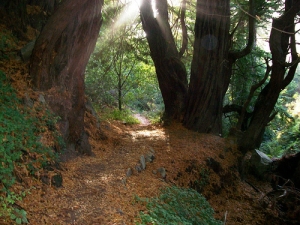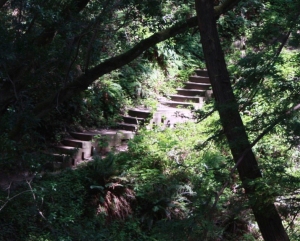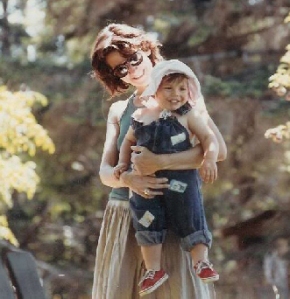Originally posted May 19, 2010)

When life at the Barn gets too intense, which it has a built-in tendency to do, I walk down Center Street to the Plaza and plunk myself down on a bench. I highly recommend it ~ find a bench, ostensibly with a view of something that has its feet firmly planted in the earth, and just sit. After a half-hour of seemingly doing nothing, you will find your personal universe begin to shift ever so slightly.
Sometimes I think great thoughts, but mostly I don’t, I’m alone with them no matter how mundane they are. Our thoughts are like our children, we always seek some redeeming feature in them. For physical health a run would probably be a better option, for speedy energy a shot of caffeine, but for an instant and refreshing change in perspective very few things beat a park bench.

he secret to this particular form of self-medicating is to leave your cell phone ~ blackberry, ipod, laptop, singly or in any combination ~ behind. This is not as easy as it may sound. We all appear to be increasingly addicted to our techno toys, more than we care to admit. Sitting on the bench this week I counted, in the first 50 people who ambled by on their own, 34 who were walking while texting, talking, or listening to something other than the birds in the trees. This was not even counting the groups of people in which someone seemingly “in” the group was simultaneously engaged in a conversation with someone not even there. We go on and on about how little quality time we are able to find in our oversubscribed lives; where once the mantra for our culture was ‘knowledge is power’, now we moan and groan about ‘too much information.’ Why then, do we find it so hard to turn off convergent technology? We are sensible people, right? Where does this insatiable desire to be connected ALL THE TIME at the expense of our and everyone else’s privacy ~ and perhaps our sanity ~ come from?
My first thought sitting on the bench was that digital social mediums wire directly into the part of our brains that bows to a social hierarchy where not much has changed since High School ~ if you aren’t in, you are out. Nobody wants to be left out. The rise of twitching twittering facebook communities seems to support this theory ~ digital popularity as the new religion, documentation of even the smallest details of our lives, as the new confession.
But I had another thought a few hours later, as I watched a man leave the warm and beautiful dining room in Barndiva to go outside in the rain to reply to a text, despite the candlelight, the music and what seemed like an engaging conversation he was having with his girlfriend and another couple. Perhaps our fear of ‘turning off’ rises from a deeper genetic imperative, an urge to know what’s coming before it arrives. Digital Media is our Paul Revere: if we listen closely we will have time to lock the doors and gather the muskets. Or maybe it goes back further still, all the way to our cave dwelling ancestors, where “knowledge is power” really did mean the difference between life and death. You eat the bear or the bear eats you.
In which case this unquenchable desire for information is a rather cool, if subconscious, form of self-protection. The question then becomes, protection from what? What, in modern times, is the bear?
 Probably the same thing it’s always been, (when it wasn’t an actual bear), we are, deep down, desperately afraid we’re living unexamined lives and that we will die without ever figuring out what the point was. But trying to find out what the point is, much less finding a point worth living for is an increasingly quixotic challenge. We exist in a world where global warming is touted as a myth, Sarah Palin is considered sartorial, Monsanto “helps farmers learn to be sustainable,” and the oil slick soaking the coastlines on one of the most fragile ecosystems in the world, is, according to a “pre-eminent” scientists quoted in The New York Times, “not as bad as you think.” We live in a world where verifiable truth is taking a beating ~ let's face it ladies and gentlemen, truth gets the shit beat out of it every day. Which makes it awfully hard to follow the real storyline of history anymore, much less how our lives might intersect, and even be reflected, in it.
Probably the same thing it’s always been, (when it wasn’t an actual bear), we are, deep down, desperately afraid we’re living unexamined lives and that we will die without ever figuring out what the point was. But trying to find out what the point is, much less finding a point worth living for is an increasingly quixotic challenge. We exist in a world where global warming is touted as a myth, Sarah Palin is considered sartorial, Monsanto “helps farmers learn to be sustainable,” and the oil slick soaking the coastlines on one of the most fragile ecosystems in the world, is, according to a “pre-eminent” scientists quoted in The New York Times, “not as bad as you think.” We live in a world where verifiable truth is taking a beating ~ let's face it ladies and gentlemen, truth gets the shit beat out of it every day. Which makes it awfully hard to follow the real storyline of history anymore, much less how our lives might intersect, and even be reflected, in it.
 I get all that. What is deeply worrying is that instead of shifting our search for insight elsewhere, using these astonishing media tools and outlets to develop critical wherewithal, we choose to drop the pro and dity in the search for profundity and just go all out for FUN. It's fun to document the minutiae of our lives, and if anyone laughs at us, so what? We, in turn, through the wonders of tweets, facebook, youtube, twiddish, etc. are laughing at them as well. As for traditional ports of call ~ Art, Film, Music ~ where we once sought and found meaningful narratives that reflected a whole range of human values, the work that now gets produced has become, by and large, contrived product placements in-filled with perishable and disposable information. We are manipulated, pandered to, and infantilized from virtually every medium where sales, not enlightment, is the driving force.
I get all that. What is deeply worrying is that instead of shifting our search for insight elsewhere, using these astonishing media tools and outlets to develop critical wherewithal, we choose to drop the pro and dity in the search for profundity and just go all out for FUN. It's fun to document the minutiae of our lives, and if anyone laughs at us, so what? We, in turn, through the wonders of tweets, facebook, youtube, twiddish, etc. are laughing at them as well. As for traditional ports of call ~ Art, Film, Music ~ where we once sought and found meaningful narratives that reflected a whole range of human values, the work that now gets produced has become, by and large, contrived product placements in-filled with perishable and disposable information. We are manipulated, pandered to, and infantilized from virtually every medium where sales, not enlightment, is the driving force.
 Of course Will Shakespeare wanted people to attend his plays as a testament to his genius, but can we assume he didn’t need product placement to get the bard mojo working? If Jean Luc Godard had to track first day ticket sales, would the French New Wave have survived? Where are the Van Goghs and the John Coltranes, who never made a dime out of painting or playing their hearts out? As Thomas Wolfe knew (another example of a crazy art for arts sake guy) you can’t go home again. But where, exactly, are we going?
Of course Will Shakespeare wanted people to attend his plays as a testament to his genius, but can we assume he didn’t need product placement to get the bard mojo working? If Jean Luc Godard had to track first day ticket sales, would the French New Wave have survived? Where are the Van Goghs and the John Coltranes, who never made a dime out of painting or playing their hearts out? As Thomas Wolfe knew (another example of a crazy art for arts sake guy) you can’t go home again. But where, exactly, are we going?
If everything we are and everything we love, need, and desire, issues from a personal set of values that can only start its engines when our eyes or our ears engage, it's probably a good idea to take a critical look from time to time at how we form those values, what feeds them, and, crucially, what we need to do to keep them humming. When we lose control of the intricate plot of our lives, even for a little while, we lose the linkages that connect one thing to another ~ before you know it you are inside the mouth of the bear.

The great photographer Henri Cartier-Bresson believed “There is nothing in this world that does not have a decisive moment." By decisive he meant personally verifiable. Bresson wasn’t out to prove things only happen because we see them, but that with patience and perception human beings have the power to visually organize the world so it fits a pattern that means something, and from that pattern a blueprint for living can emerge.
Two years after the second World War ended, when Bresson was, in his own words, “completely lost,” he threw in with fellow photographers George Rodger, Robert Capa and David “Chim” Seymour” to found Magnum, “ a community of thought, a shared human quality, a curiosity about what is going on in the world, a respect for what is going on and a desire to transcribe it visually."
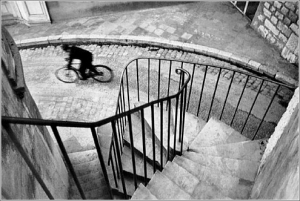 It seems to me, even If you never pick up a camera, that these are words to live by today ~ curiosity and respect for and about the human condition, fueled by a desire to create a community of thought based upon shared human values. Decisive moments occur in all of our lives, you don’t need to be a Magnum photographer to find them. You do need the time to look and process, in your own mind, the meaning of what you see. You need time to find the artists out there who are still committed to telling a human story of struggle, for only in that kind of story will we also discover the tools to survive.
It seems to me, even If you never pick up a camera, that these are words to live by today ~ curiosity and respect for and about the human condition, fueled by a desire to create a community of thought based upon shared human values. Decisive moments occur in all of our lives, you don’t need to be a Magnum photographer to find them. You do need the time to look and process, in your own mind, the meaning of what you see. You need time to find the artists out there who are still committed to telling a human story of struggle, for only in that kind of story will we also discover the tools to survive.
 The technological sensory overload we all suffer from does not encourage this process. Just having more information at our fingertips does not make us smarter. And we need to get smarter, really fast, because what all our wonderful social media and popular entertainments aren’t telling us is that the bear is gaining.
The technological sensory overload we all suffer from does not encourage this process. Just having more information at our fingertips does not make us smarter. And we need to get smarter, really fast, because what all our wonderful social media and popular entertainments aren’t telling us is that the bear is gaining.
 RESOURCES
Museums, libraries and bookshops with more re-prints than top sellers are still the best places to experience art that has transforming powers.
Dance and Opera are two art forms which, for very different reasons, have both proved artistically resilient and deserve your patronage. Both are great value (Opera only if you watch it via satellite feed).
RESOURCES
Museums, libraries and bookshops with more re-prints than top sellers are still the best places to experience art that has transforming powers.
Dance and Opera are two art forms which, for very different reasons, have both proved artistically resilient and deserve your patronage. Both are great value (Opera only if you watch it via satellite feed).
To watch great cinema, which is still being made (but you won’t find at your local 12 plex) check out www.filmmovement.com. Not a bad film in the bunch, join or risk them being checked out at Blockbuster.
To hear stimulating music and life affirming conversation, check out programs offered at the Herbst Theatre, especially the City Arts and Lectures Series. One of the best nights I had last year was sitting with Geoff and Lukka, listening to Wendell Berry talking with Michael Pollen. Two human beings sitting on a stage just having a chat and it was riveting. How about that? I missed Frank Rich and Mark Danner in April and I’m still kicking myself.
Intersection 5M- a satellite art space, screening room, and event space in SF worth keeping track of. 5M features local exhibitions focused around arts for change. The inaugural gallery exhibit includes our friend Laura Parker: Let's Talk of a System

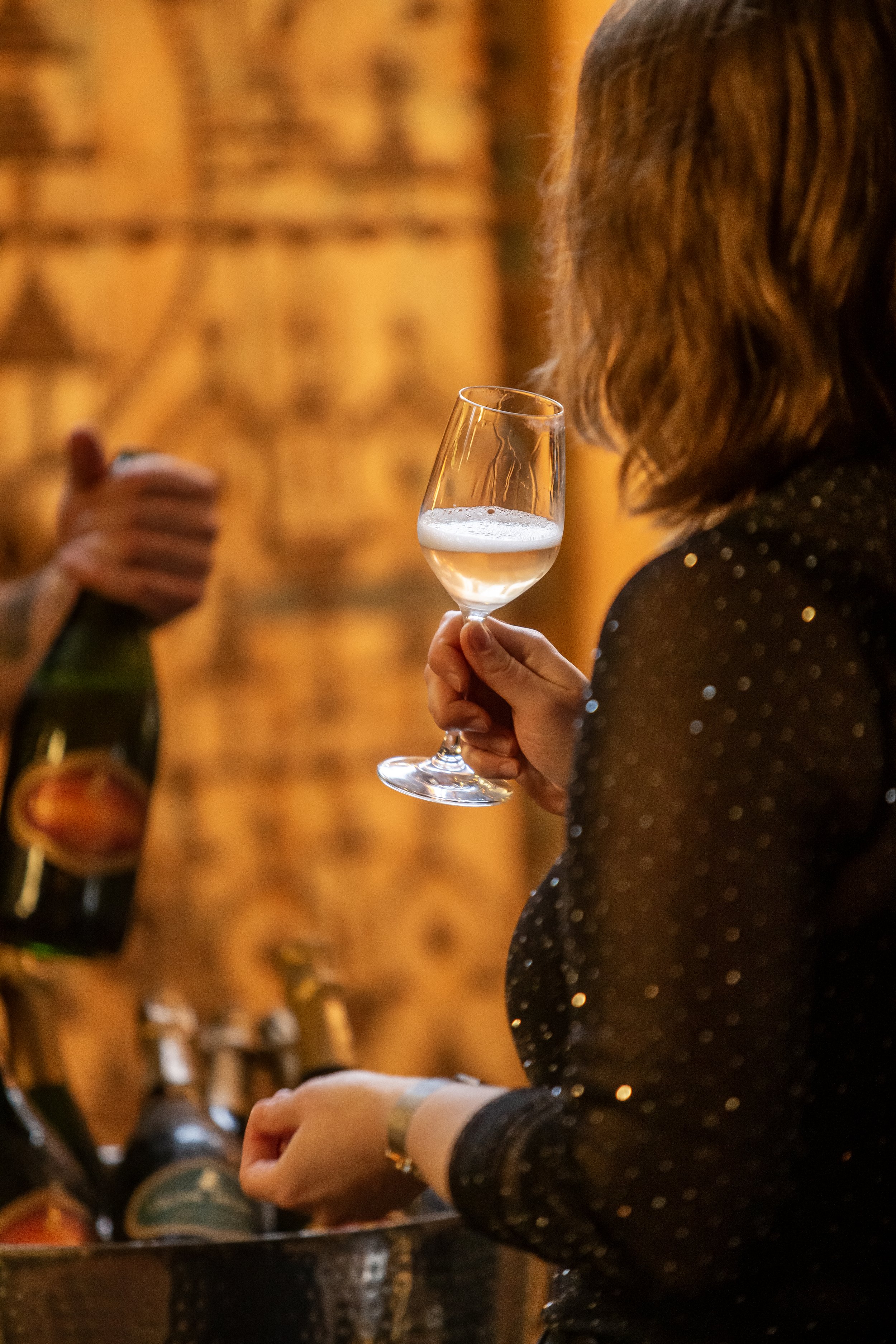



























 Place flour on a cutting board, making a well in the middle.
Add eggs, milk, olive oil.
With a fork whisk the egg mixture slowly incorporating the flour.
Knead the dough until completely smooth.
Let rest at least 20 min, then roll
Eggs for our pasta sourced from our friends at Quivera
and Earlybirds Place.
Place flour on a cutting board, making a well in the middle.
Add eggs, milk, olive oil.
With a fork whisk the egg mixture slowly incorporating the flour.
Knead the dough until completely smooth.
Let rest at least 20 min, then roll
Eggs for our pasta sourced from our friends at Quivera
and Earlybirds Place.







